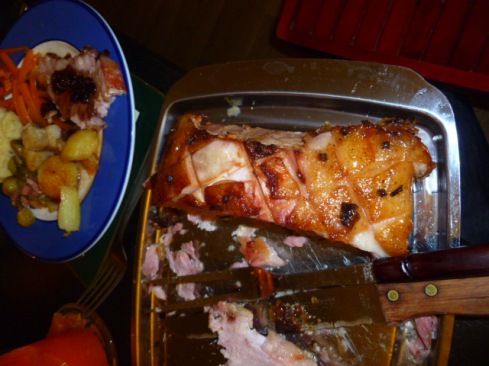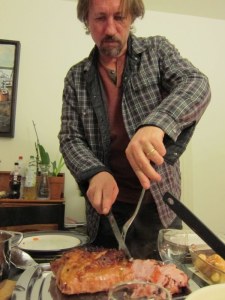The Swedes are a very traditional bunch at Christmas, and everything must take place in a particular order. They celebrate on Christmas eve, which starts with a bowl of Risgrynsgröt, which is essentially sloppy rice pudding with no sugar in. The celebrations do not start until their annual Disney clip show, Kalle Anka och hans vänner önskar God Jul: “Donald Duck and his friends wish you a Merry Christmas.”, has finished. This was originally made in 1958, and they Swedified it, taking off Walt Disney’s narration, and adding a Swedish guy. They show it every year at 3pm, and woe betide you if you choose to call in the middle of it! They show the same clips, in the same order, every year, and no-one talks during it at all. I understand that they tried to change some of the clips one year, but so many people wrote in to complain that they have never dared try that again. I am not the only non-Swede to have been baffled by their absolute enthrallment by this programme.
After Kalle Anke, they have their Christmas meal. This is as traditional and not-to-be-messed-with as old Kalle and his clip show. As well as inlagd sill (which must be eaten with a beer), they always, always have a baked ham, served cold, meatballs, Prinskorv, and very little in the way of vegetables (unless you count beetroot in one of the herring dishes).
In the UK it has become traditional to have a turkey or a goose, roasted in the oven at Christmas, served alongside a number of cooked veg, often with the much-loathed Brussels sprouts as an accompaniment. We probably have loads of things that the Big Guy finds odd too – I remember his reaction the first year he got crackers, he loved all of that, and just could not stop giggling at the rubbish cracker jokes. I am not as aware of our idiosyncrasies in this regard, but if he wants to go on about them, he should probably start his own blog!
The great thing about having a non-traditional Christmas dinner, especially when it is not actually Christmas day, is that you can mix it up a bit, and dispense with some things altogether. A number of my guests enjoy my hot roast dinners, but I don’t really like turkey or goose (although I recently had wild goose, and loved that, I find domestic geese just too fatty for my taste), so I decided that a mix of the traditions was the way forward, and settled on a baked ham, with the traditional roasted and cooked veggies on the side, including an acceptable way with sprouts.
I had intended to do a gammon, but due to a bit of a loss in translation, I got a nice piece of what I suspect was raw back bacon instead. Never mind, I have a lovely butcher, and so next time I want one, I know what to ask for. This, folks, is one of the many benefits of using a butcher over buying meat from a supermarket. On top of this, we swapped tips on how I was going to cook it, and also what sauce to use. Please support local butchers, it really is a case of use them or lose them right now, as more of them lose out to the supermarkets. It would be a shame to lose their knowledge, miss out on some useful banter, or even improve your language skills (not guaranteed if you and your butcher have the same mother tongue, but you could be surprised)
I originally got this recipe from the Dairy Book of Home Cookery which was produced by the Milk Marketing Board, and you used to have to buy it from your milkman (remember them?). It has been published since 1972, and is practically an institution, almost as entrenched in British households as stopping everything for Kalle Anke is in Sweden.
We are currently on holiday in Australia, and so due to travelling, I have not been able to get this post finished before Christmas. I decided to publish it anyway, as it is a great roast dinner and a good celebratory meal, whatever you are celebrating.
This was to feed 8 adults and one small child, but you can adjust your ham/ gammon according to how many people that you have to feed, and how much you want for lovely leftovers.
Recipe: Baked, Glazed Ham & Crackling
Ingredients
2.1 kg raw ham or gammon, skin on. I got mine vacuum packed, but this may not be possible.
Cloves
100g muscovado sugar or donker basterdsuiker
200 ml apple juice or cider
1 tbsp Worcestershire Sauce
1 tsp English mustard powder
Method
If you have a large gammon, you need to soak it for at least 12 hours, with several changes of water, to remove the salt.
Next, you will need to boil the ham. If you have ham like mine, or you have access to a vacuum packer, I recommend boiling it sealed. This will require less boiling, and will help keep the finished ham moist. If you are boiling it this way, you will need an hour. If you are not using a vacuum seal, then boil it for up to 2 hours, in plain water. You will definitely not need to add salt for this one. I usually add onion, carrots, celery and bay, to make a lot of stock. Either way you cook the ham, it must remain covered with water, so place a plate over it, and use weights, if necessary. Check regularly throughout the boil to see if the water may need to be topped up. If you do need a top-up, use boiling water from the kettle, don’t add cold and reduce the water temperature.
When the ham has finished boiling, take it out of the water. If it is vacuum sealed, then be careful to retain the stock that will have been made within the plastic. If you have boiled it plain, then keep the boiling stock, but remove the vegetables. Either way, you will have a lovely, rich, gelatinous stock, which is great with bean dishes, stews and soups. Leave it to cool, and remove the fat, but please don’t throw it away!
Next, remove the skin. Try to keep a thin layer of the fat on the ham, because this will help with the glaze. You also need some of the fat on the skin, if you want your crackling to be lovely and crisp.
Score the skin, but don’t cut it all the way through, if possible. You want a block of the skin, which can be carved up later. Rub a fair bit of salt, and herbs or spices into the skin – I used fennel seeds, but cumin, rosemary, lemon zest, jerk seasoning, or a garam masala would all be equally good. You could rub with a little bit of olive oil first, to make sure the seasoning sticks, but this is not entirely necessary. Do make sure you rub the salt and spies into the slashes as well.
Place the skin in a roasting tray and put it in an oven at 180°C. Start to check after 20 minutes and remove when the skin has formed crisp crackling. This can be made ahead of time and warmed through when you want to serve it.
When the crackling is in the oven, carefully score the fat on the ham, taking care not to slash the flesh. You want to score lines going one way, then turn it 90 degrees, , and score in lines again, so that you end up with a diamond pattern over the ham. Stick a clove through the fat, and anchor in the meat on alternate diamonds.
The rest of the ingredients will make up the glaze. Put them all in a saucepan, and warm through until the sugar has melted. It should be quite viscous, which makes it easier to glaze the whole ham with, without too much running over the sides.
Spread all of the glaze over the ham. Make sure that it is covering all the fat, and don’t worry if some of it dribbles down the sides of the meat, it all adds to the flavour.
Bake the ham at 180°C for 40 minutes to an hour, depending on the thickness of the meat. If you have a meat thermometer, you want to keep the meat at 80°C, which will keep the meat moist. I don’t have one of these, so I judge it by sticking a skewer in the thickest part of the meat, and seeing if it is warm. The temperature thing was a tip from my butcher, so rather than waste the advice, I thought I would share it here.
Baste the ham with the glaze at least twice throughout the baking process, to maximise the flavours and to use up that delicious glaze.
Serve it with the crackling, some cooked veggies (including roast potatoes), and a thick sauce made from chopped shallot, port wine, ground cloves, and muscovado sugar.
This is a real treat and great for any celebration. As you won’t have been able to read this for Christmas, I would like to wish you a very happy and prosperous New Year.
(c) J. Caspar 2011




